产品中心
当前位置:首页>产品中心Anti-Fas Ligand
货号: bs-0216R 基本售价: 380.0 元 规格: 20ul
- 规格:20ul
- 价格:380.00元
- 规格:50ul
- 价格:780.00元
- 规格:100ul
- 价格:1380.00元
- 规格:200ul
- 价格:2200.00元
产品信息
- 产品编号
- bs-0216R
- 英文名称
- Fas Ligand
- 中文名称
- FasL抗体
- 别 名
- APO1L; Apoptosis (APO 1) antigen ligand 1; Fas-L; Apoptosis antigen ligand 1; APTL; CD178; CD-178; CD 178; CD95L; CD95 ligand; CD95-L; CD95L protein; FAS antigen ligand; Fas L; Fas Ligand; FASL; Fasl; Fas ligand (TNF superfamily member 6); Generalized lymphoproliferative disease; TNF superfamily member 6; TNFSF6; Tumor necrosis factor ligand superfamily member 6; TNFL6_HUMAN; Apoptosis antigen ligand; Tumor necrosis factor ligand superfamily member 6, membrane form; Tumor necrosis factor ligand superfamily member 6, soluble form; FASLG.

- Specific References (8) | bs-0216R has been referenced in 8 publications.
- 规格价格
- 50ul/780元购买 100ul/1380元购买 200ul/2200元购买 大包装/询价
- 说 明 书
- 50ul 100ul 200ul
- 研究领域
- 肿瘤 细胞生物 免疫学 细胞凋亡
- 抗体来源
- Rabbit
- 克隆类型
- Polyclonal
- 交叉反应
- Human, Mouse, Rat, Cow,
- 产品应用
- WB=1:500-2000 ELISA=1:500-1000 IHC-P=1:400-800 IHC-F=1:400-800 Flow-Cyt=1μg/Test ICC=1:100-500 IF=1:100-500 (石蜡切片需做抗原修复)
not yet tested in other applications.
optimal dilutions/concentrations should be determined by the end user.
- 分 子 量
- 31kDa
- 细胞定位
- 细胞核 细胞膜 细胞外基质 分泌型蛋白
- 性 状
- Lyophilized or Liquid
- 浓 度
- 1mg/ml
- 免 疫 原
- KLH conjugated synthetic peptide derived from human Fas Ligand:196-281/281
- 亚 型
- IgG
- 纯化方法
- affinity purified by Protein A
- 储 存 液
- 0.01M TBS(pH7.4) with 1% BSA, 0.03% Proclin300 and 50% Glycerol.
- 保存条件
- Store at -20 °C for one year. Avoid repeated freeze/thaw cycles. The lyophilized antibody is stable at room temperature for at least one month and for greater than a year when kept at -20°C. When reconstituted in sterile pH 7.4 0.01M PBS or diluent of antibody the antibody is stable for at least two weeks at 2-4 °C.
- PubMed
- PubMed
- 产品介绍
- background:
FasL (CD95L) is a cytokine that binds to TNFRSF6/FAS, a receptor that transduces the apoptotic signal into cells. May be involved in cytotoxic T cell mediated apoptosis and in T cell development. TNFRSF6/FAS-mediated apoptosis may have a role in the induction of peripheral tolerance, in the antigen-stimulated suicide of mature T cells, or both. Binding to the decoy receptor TNFRSF6B/DcR3 modulates its effects. Homotrimer (Probable). May be released as type II membrane protein. Belongs to the tumor necrosis factor family
Function:
Cytokine that binds to TNFRSF6/FAS, a receptor that transduces the apoptotic signal into cells. May be involved in cytotoxic T-cell mediated apoptosis and in T-cell development. TNFRSF6/FAS-mediated apoptosis may have a role in the induction of peripheral tolerance, in the antigen-stimulated suicide of mature T-cells, or both. Binding to the decoy receptor TNFRSF6B/DcR3 modulates its effects.
Subunit:
Homotrimer (Probable). Interacts with ARHGAP9, BAIAP2L1, BTK, CACNB3, CACNB4, CRK, DLG2, DNMBP, DOCK4, EPS8L3, FGR, FYB, FYN, HCK, ITK, ITSN2, KALRN, LYN, MACC1, MIA, MPP4, MYO15A, NCF1, NCK1, NCK2, NCKIPSD, OSTF1, PIK3R1, PSTPIP1, RIMBP3C, SAMSN1, SH3GL3, SH3PXD2B, SH3PXD2A, SH3RF2, SKAP2, SNX33, SNX9, SORBS3, SPTA1, SRC, SRGAP1, SRGAP2, SRGAP3, TEC, TJP3 and YES1.
Subcellular Location:
Cell membrane; Single-pass type II membrane protein. Secreted. Cytoplasmic vesicle lumen. Lysosome lumen. Note=May be released into the extracellular fluid, probably by cleavage form the cell surface. Is internalized into multivesicular bodies of secretory lysosomes after phosphorylation by FGR and monoubiquitination.
Post-translational modifications:
N-glycosylated.
The soluble form derives from the membrane form by proteolytic processing.
Phosphorylated by FGR on tyrosine residues; this is required for ubiquitination and subsequent internalization.
Monoubiquitinated.
DISEASE:
Defects in FASLG are the cause of autoimmune lymphoproliferative syndrome type 1B (ALPS1B) [MIM:601859]; also known as Canale-Smith syndrome (CSS). ALPS is a childhood syndrome involving hemolytic anemia and thrombocytopenia with massive lymphadenopathy and splenomegaly.
Similarity:
Belongs to the tumor necrosis factor family.
SWISS:
P48023
Gene ID:
356
Database links:Entrez Gene: 356Human
Entrez Gene: 14103Mouse
Entrez Gene: 25385Rat
Omim: 134638Human
SwissProt: P48023Human
SwissProt: P41047Mouse
SwissProt: P36940Rat
Unigene: 2007Human
Unigene: 3355Mouse
Unigene: 9725Rat
Important Note:
This product as supplied is intended for research use only, not for use in human, therapeutic or diagnostic applications.
Fas-L 是一个与TNFRSF6/FAS 结合的细胞因子,一个转导凋亡信号到细胞内的一个受体。他可能参与T-细胞调节凋亡细胞毒性和T-细胞的发育。调节凋亡的TNFRSF6/FAS 在外周组织耐受性方面和抗原刺激成熟淋巴细胞自杀中起作用。FasL诱导物受体TNFRSF6B/DcR3结合调节其作用。
FasL只表达于活化的淋巴细胞,但在小鼠睾丸中可见高表达的FasL;分子量为36-43kDa。属于TNF家族。
- 产品图片
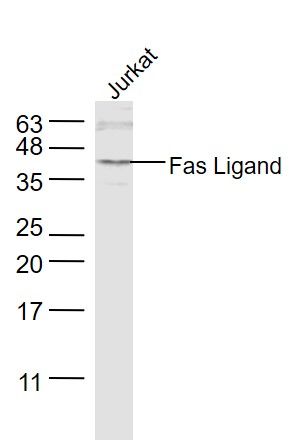 Sample:
Sample:
Jurkat(Human) Cell Lysate at 30 ug
Primary: Anti-Fas Ligand (bs-0216R) at 1/1000 dilution
Secondary: IRDye800CW Goat Anti-Rabbit IgG at 1/20000 dilution
Predicted band size: 31 kD
Observed band size: 31 kD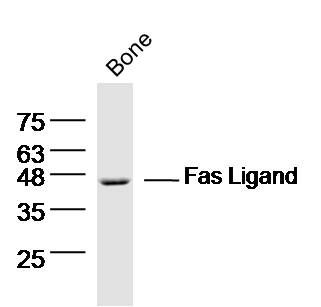 Sample: Bone (mouse) Lysate at 40 ug
Sample: Bone (mouse) Lysate at 40 ug
Primary: Anti- Fas ligand (bs-0216R) at 1/300 dilution
Secondary: IRDye800CW Goat Anti-Rabbit IgG at 1/20000 dilution
Predicted band size: 31 kD
Observed band size: 46 kD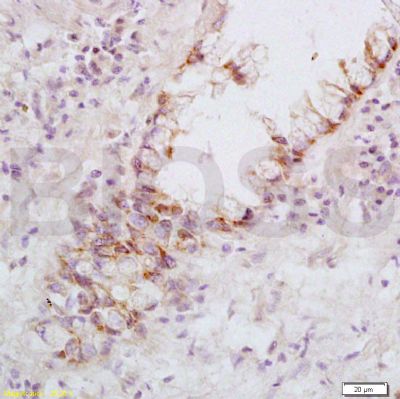 Tissue/cell: human rectal carcinoma; 4% Paraformaldehyde-fixed and paraffin-embedded;
Tissue/cell: human rectal carcinoma; 4% Paraformaldehyde-fixed and paraffin-embedded;
Antigen retrieval: citrate buffer ( 0.01M, pH 6.0 ), Boiling bathing for 15min; Block endogenous peroxidase by 3% Hydrogen peroxide for 30min; Blocking buffer (normal goat serum,C-0005) at 37℃ for 20 min;
Incubation: Anti-FasL Polyclonal Antibody, Unconjugated(bs-0216R) 1:200, overnight at 4°C, followed by conjugation to the secondary antibody(SP-0023) and DAB(C-0010) staining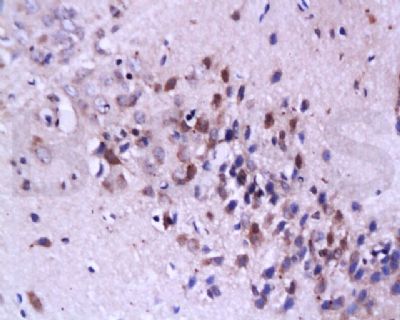 Tissue/cell: rat brain tissue; 4% Paraformaldehyde-fixed and paraffin-embedded;
Tissue/cell: rat brain tissue; 4% Paraformaldehyde-fixed and paraffin-embedded;
Antigen retrieval: citrate buffer ( 0.01M, pH 6.0 ), Boiling bathing for 15min; Block endogenous peroxidase by 3% Hydrogen peroxide for 30min; Blocking buffer (normal goat serum,C-0005) at 37℃ for 20 min;
Incubation: Anti-FasL Polyclonal Antibody, Unconjugated(bs-0216R) 1:200, overnight at 4°C, followed by conjugation to the secondary antibody(SP-0023) and DAB(C-0010) staining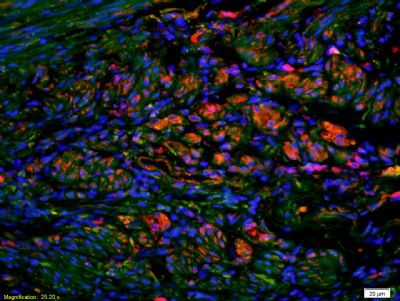 Tissue/cell: human rectal carcinoma;4% Paraformaldehyde-fixed and paraffin-embedded;
Tissue/cell: human rectal carcinoma;4% Paraformaldehyde-fixed and paraffin-embedded;
Antigen retrieval: citrate buffer ( 0.01M, pH 6.0 ), Boiling bathing for 15min; Blocking buffer (normal goat serum,C-0005) at 37℃ for 20 min;
Incubation: Anti-FasL Polyclonal Antibody, Unconjugated(bs-0216R) 1:200, overnight at 4°C; The secondary antibody was Goat Anti-Rabbit IgG, Cy3 conjugated(bs-0295G-Cy3)used at 1:200 dilution for 40 minutes at 37°C. DAPI(5ug/ml,blue,C-0033) was used to stain the cell nuclei Blank control: Mouse Kidney (blue).
Blank control: Mouse Kidney (blue).
Primary Antibody:Rabbit Anti-phospho-Fas Ligand antibody (bs-0216R,Green); Dilution: 1μg in 100 μL 1X PBS containing 0.5% BSA;
Isotype Control Antibody: Rabbit IgG(orange) ,used under the same conditions;
Secondary Antibody: Goat anti-rabbit IgG-FITC(white blue), Dilution: 1:200 in 1 X PBS containing 0.5% BSA.
Protocol
The cells were fixed with 2% paraformaldehyde for 10 min at 37℃. Primary antibody (bs-0216R, 1μg /1x10^6 cells) were incubated for 30 min at room temperature, followed by 1 X PBS containing 0.5% BSA + 1 0% goat serum (15 min) to block non-specific protein-protein interactions. Then the Goat Anti-rabbit IgG/FITC antibody was added into the blocking buffer mentioned above to react with the primary antibody at 1/200 dilution for 40 min on ice. Acquisition of 20,000 events was performed.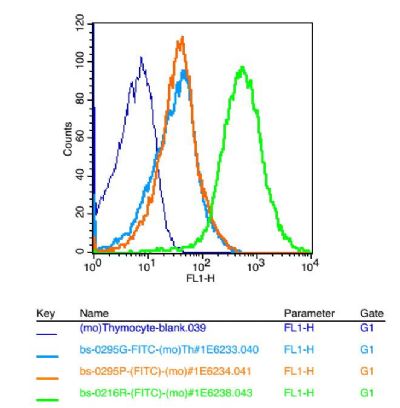 Blank control: mouse thymouses(blue)
Blank control: mouse thymouses(blue)
Isotype Control Antibody: Rabbit IgG(orange) ; Secondary Antibody: Goat anti-rabbit IgG-FITC(white blue), Dilution: 1:100 in 1 X PBS containing 0.5% BSA ; Primary Antibody Dilution: 1μl in 100 μL1X PBS containing 0.5% BSA(green).

